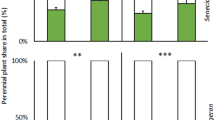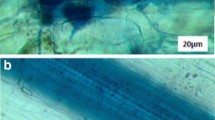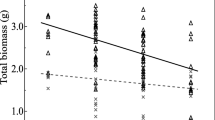Abstract
Arbuscular mycorrhizal fungi (AMF) are known to improve plant growth and nutrition and therefore are likely to affect the competitive relationships between crops and weeds. In this study, we evaluated whether AMF (Funneliformis mosseae, Rhizoglomus fasciculatum, Rhizoglomus intraradices) change plant competition between Phaseolus vulgaris and the weeds Solanum nigrum L., Digitaria sanguinalis L., and Ipomoea purpurea L. Mycorrhizal colonization, aggressivity index, photosynthetic rates, and yield parameters were measured. While the presence of AMF reduced the total biomass of D. sanguinalis and S. nigrum when grown in competition with P. vulgaris, it increased the total biomass of I. purpurea when grown with P. vulgaris. Significantly, elevated mycorrhizal growth responses (38–44%) improved the competitive ability of I. purpurea. In contrast, the competitive ability of S. nigrum was increased only when plants colonized by R. intraradices. The total protein content of P. vulgaris pods when in competition was negatively affected by AMF, thus leading to low nutritional quality. The results suggest that AMF have the potential to affect the outcome of weed—P. vulgaris competition. We demonstrate that not only colonization with AMF but also AMF species can affect the competitive relationships between crops and weeds, and thus, AMF represent key soil organisms to be taken into account in sustainable weed management strategies.







Similar content being viewed by others
Data availability
Data are available from the corresponding author.
References
Aerts R, Chapin FS III (1999) The mineral nutrition of wild plants revisited: a re-evaluation of processes and patterns. Adv Ecol Res 30:1–67
Ågren GI (2008) Stoichiometry and nutrition of plant growth in natural communities. Annu Rev Ecol Evol Syst 39:153–170
Aguyoh JN, Masiunas JB (2003) Interference of large crabgrass (Digitaria sanguinalis) with snap beans. Weed Sci 51:171–176
Ahmadi A, Mirzaei TR, Mousavi SK, Mohammadi H (2007) Determination of the critical period of weed control in dry bean using a thermal basis. Iran J Weed Sci 3:21–38
Allen MF, Allen EB, Friese CF (1989) Responses of the non7hyphen; mycotrophic plant Salsola kali to invasion by vesicular–arbuscular mycorrhizal fungi. New Phytol 111:45–49
Arnon D, Hoagland D (1939) A comparison of water culture and soil as media for crop production. Science 89:512–514
Bates RT, Gallagher RS, Curran WS, Harper JK (2012) Integrating mechanical and reduced chemical weed control in conservation tillage corn. Agron J 104:507–517
Bjorkman O (1976) Adaptive and genetic aspects of C4 photosynthesis. In: Burris RH, Black CC (eds) Metabolism and Plant Productivity. University Park Press, Baltimore, Madison, pp 287–309
Bradford MM (1976) A rapid and sensitive method for the quantitation of microgram quantities of protein utilizing the principle of protein-dye binding. Anal Biochem 72:248–254
Buchanan GA, Burns ER (1971) Weed competition in cotton, I: sicklepod and tall morningglory. Weed Sci 19:576–579
Bukun B (2004) Critical periods for weed control in cotton in Turkey. Weed Res 44:404–412
Chapin FS III, Matson PA, Vitousek P (2011) Principles of terrestrial ecosystem ecology. Springer, New York
Chen D et al (2016) Genotypic variation in growth and physiological response to drought stress and re-watering reveals the critical role of recovery in drought adaptation in maize seedlings. Front Plant Sci 6:1–15
Crowley RH, Buchanan GA (1978) Competition of four morning glory (Ipomoea spp.) species with cotton (Gossypium hirsutum). Weed Sci 26:484–488
Crush J (1974) Plant growth responses to vesicular-arbuscular mycorrhiza VII. Growth and modulation of some herbage legumes. New Phytol 73:743–749
Dawit D, Sharma J, Lisanework N (2011) Effect of pendimethalin and S-metolachlor application rates on weed dynamics and yield of common bean (Phaseolus vulgaris L.) at Areka. Ethiopia Ethiopian Journal of Weed Management 4:37–53
Edwards GE, Huber SC (1981) The C4 pathway. In: Hatch MD, Boardman NK (eds) The biochemistry of plants. Academic Press, New York, A comprehensive treatise, pp 237–281
Espinosa-Páez E, Alanis-Guzmán M, Hernández-Luna CE, Báez-González JG, Amaya-Guerra CA, Andrés-Grau AM (2017) Increasing antioxidant activity and protein digestibility in Phaseolus vulgaris and Avena sativa by fermentation with the Pleurotus ostreatus Fungus. Molecules 22:1–11
Flint EP, Patterson DT, Beyers JL (1983) Interference and temperature effects on growth of cotton (Gossypium hirsutum), spurred anoda (Anoda cristata), and velvetleaf (Abutilon theophrasti). Weed Sci 31:892–898
Francis R, Read D (1995) Mutualism and antagonism in the mycorrhizal symbiosis, with special reference to impacts on plant community structure. Can J Bot 73:1301–1309
Ganjeali A, Ashiani E, Zare M, Tabasi E (2018) Influences of the arbuscular mycorrhizal fungus Glomus mosseae on morphophysiological traits and biochemical compounds of common bean (Phaseolus vulgaris) under drought stress. S Afr J Plant Soil 35:121–127
Gee GW, Bauder JW (1986) Particle-size analysis1 methods of soil analysis: part 1—physical and mineralogical methods (Methodsofsoilan1), pp 383–411
Gosling P, Mead A, Proctor M, Hammond JP, Bending GD (2013) Contrasting arbuscular mycorrhizal communities colonizing different host plants show a similar response to a soil phosphorus concentration gradient. New Phytol 198:546–556
Grace E, Cotsaftis O, Tester M, Smith F, Smith S (2009) Arbuscular mycorrhizal inhibition of growth in barley cannot be attributed to extent of colonization, fungal phosphorus uptake or effects on expression of plant phosphate transporter genes .New Phytol 181:938–949
Habte M, Turk D (1991) Response of two species of cassia and Gliricidia sepium to vesicular-arbuscular mycorrhizal infection. Commun Soil Sci Plant Anal 22:1861–1872
Hall I (1978) Effects of endomycorrhizas on the competitive ability of white clover. New Zeal J Agr Res 21:509–515
Hayman D, Mosse B (1972) role of vesicular-arbuscular mycorrhiza in the removal of phosphorus from soil by plant roots. Rev Ecol Biol Sol 9:463–470
Hikosaka K, Osone Y (2009) A paradox of leaf-trait convergence: why is leaf nitrogen concentration higher in species with higher photosynthetic capacity? J Plant Res 122:245–251
Høgh-Jensen H (2006) The nitrogen transfer between plants: an important but difficult flux to quantify. Plant Soil 282:1–5
Islam M, Kim JW, Begum M, Sohel M, Taher A, Lim Y-S (2020) Physiological and biochemical changes in sugar beet seedlings to confer stress adaptability under drought condition .Plants 9:1511
Johnson NC (2010) Resource stoichiometry elucidates the structure and function of arbuscular mycorrhizas across scales. New Phytol 185:631–647
Johnson NC, Graham J, Smith F (1997) Functioning of mycorrhizal associations along the mutualism–parasitism continuum. New Phytol 135:575–585
Johnson NC, Rowland DL, Corkidi L, Egerton-Warburton LM, Allen EB (2003) Nitrogen enrichment alters mycorrhizal allocation at five mesic to semiarid grasslands. Ecology 84:1895–1908
Johnson RJ (1971) Effect of weed competition on sunflower. Weed Sci 19:378–380
Jordan NR, Larson DL, Huerd SC (2008) Soil modification by invasive plants: effects on native and invasive species of mixed-grass prairies. Biol Invasions 10:177–190
Kebede M, Sharma J, Tana T, Nigatu L (2013) Influence of weed dynamics on the productivity of common bean (Phaseolus vulgaris L.) in Eastern Ethiopia. East Afr J Sci 7:109–120
Lim T (2012) Phaseolus vulgaris. In: Edible medicinal and non-medicinal plants. Springer, pp 815–848
Lin G, McCormack ML, Guo D (2015) Arbuscular mycorrhizal fungal effects on plant competition and community structure. J Ecol 103:1224–1232
Mariotte P, Vandenberghe C, Kardol P, Hagedorn F, Buttler A (2013) Subordinate plant species enhance community resistance against drought in semi-natural grasslands. Jo Ecol 101:763–773
McGilchrist C, Trenbath B (1971) A revised analysis of plant competition experiments. Biometrics 21:659–671
Meng L, Zhang A, Wang F, Han X, Wang D, Li S (2015) Arbuscular mycorrhizal fungi and rhizobium facilitate nitrogen uptake and transfer in soybean/maize intercropping system. Front Plant Sci 6:339–349
Mitra D, Uniyal N, Panneerselvam P, Senapati A, Ganeshamurthy A (2019) Role of mycorrhiza and its associated bacteria on plant growth promotion and nutrient management in sustainable agriculture International. Int J Life Sci Appl Sci 1:1–10
Mohammadi G, Amiri F (2011) Critical period of weed control in soybean (Glycine max) as influenced by starter fertilizer Australian. J Crop Sci 5:1350–1355
Moyer-Henry KA (2006) Plant responses to stress in acid environments: an assessment of the role of mycorrhizal fungi. Graduate Faculty of North Carolina State University, North Carolina
Mukhongo R, Tumuhairwe J, Ebanyat P, AbdelGadir AH, Thuita M, Masso C (2016) Production and use of arbuscular mycorrhizal fungi inoculum in Sub-Saharan Africa: challenges and ways of improving. Int J Soil Sci 11:108–122
Nazeri NK, Lambers H, Tibbett M, Ryan MH (2014) Moderating mycorrhizas: arbuscular mycorrhizas modify rhizosphere chemistry and maintain plant phosphorus status within narrow boundaries. Plant Cell Environ 37:911–921
Okon I, Osonubi O, Sanginga N (1996) Vesicular-arbuscular mycorrhiza effects on Gliricidia sepium and Senna siamea in a fallowed alley cropping system. Agrofor Syst 33:165–175
Oliver LR, Frans ER, Talbert RE (1976) Field competition between tall morning glory and soybean. Weed Sci 24:482–488
Olsen SR (1954) Estimation of available phosphorus in soils by extraction with sodium bicarbonate. United States Department Of Agriculture, Washington
Omacini M, Eggers T, Bonkowski M, Gange A, Jones T (2006) Leaf endophytes affect mycorrhizal status and growth of co-infected and neighbouring plants. Funct Ecol 20:226–232
Pereira M, Teixeira R, Souza G, Silva J, Martins D (2011) Inhibition of the initial development of sunflower, corn and triticale plants by crabgrass. Planta Daninha 29:305–310
Phillips JM, Hayman D (1970) Improved procedures for clearing roots and staining parasitic and vesicular-arbuscular mycorrhizal fungi for rapid assessment of infection. Trans Brit Mycol Soc 55:158–161
Rinaudo V, Bàrberi P, Giovannetti M, van der Heijden MG (2010) Mycorrhizal fungi suppress aggressive agricultural weeds. Plant Soil 333:7–20
Rouphael Y et al (2015) Arbuscular mycorrhizal fungi act as biostimulants in horticultural crops. Sci Hortic 196:91–108
Scheublin TR, Van Logtestijn RS, Van Der Heijden MG (2007) Presence and identity of arbuscular mycorrhizal fungi influence competitive interactions between plant species. J Ecol 95:631–638
Shinde B, Jaya T (2015) Influence of arbuscular mycorrhizal fungi on chlorophyll, proteins, proline and total carbohydrates content of the pea plant under water stress condition. Int J Curr Microbiol Appl Sci 4:809–821
Smith FA, Smith SE (2013) How useful is the mutualism-parasitism continuum of arbuscular mycorrhizal functioning? Plant Soil 363:7–18
Smith S, Read D (2008) Mineral nutrition, toxic element accumulation and water relations of arbuscular mycorrhizal plants Mycorrhizal symbiosis, 3rd edn. Academic Press, London, pp 145–148
Smith SE, Read DJ (2010) Mycorrhizal symbiosis. Academic press, London
Stagnari F, Pisante M (2011) The critical period for weed competition in French bean (Phaseolus vulgaris L.) in Mediterranean areas. Crop Prot 30:179–184
Sun Z, Song J, Xa X, Xie X, Zhao B (2018) Arbuscular mycorrhizal fungal 14-3-3 proteins are involved in arbuscule formation and responses to abiotic stresses during AM symbiosis. Front Microbiol 5:9–19
Ugen MA, Wien HC, Wortmann CS (2002) Dry bean competitiveness with annual weeds as affected by soil nutrient availability. Weed Sci 50:530–535
Uko AE, Udo IA, Effa EB (2019) Research article growth and yield responses of groundnut (Arachis hypogaea L.) to arbuscular mycorrhizal fungi inoculation in Calabar. Nigeria Asian J Plant Sci 11:8–16
Van Der Heijden MG (2002) Arbuscular mycorrhizal fungi as a determinant of plant diversity: in search of underlying mechanisms and general principles. In: Mycorrhizal ecology. Springer, pp 243–265
Van Der Heijden MG, Bardgett RD, Van Straalen NM (2008) The unseen majority: soil microbes as drivers of plant diversity and productivity in terrestrial ecosystems. Ecol Lett 11:296–310
Van der Heijden MG, Martin FM, Selosse MA, Sanders IR (2015) Mycorrhizal ecology and evolution: the past, the present, and the future. New Phytol 205:1406–1423
Vatovec C, Jordan N, Huerd S (2005) Responsiveness of certain agronomic weed species to arbuscular mycorrhizal fungi. Renew Agri Food Syst 20:181–189
Vázquez-de-Aldana BR, García-Criado B, Vicente-Tavera S, Zabalgogeazcoa I (2013) Fungal endophyte (Epichloë festucae) alters the nutrient content of Festuca rubra regardless of water availability. PLoS One 8:e84539
Veiga RS, Jansa J, Frossard E, van der Heijden MG (2011) Can arbuscular mycorrhizal fungi reduce the growth of agricultural weeds? PloS one 6:e27825
Wagg C, Jansa J, Stadler M, Schmid B, Van Der Heijden MG (2011) Mycorrhizal fungal identity and diversity relaxes plant–plant competition. Ecology 92:1303–1313
Wilson RG (1993) Wild proso millet (Panicum miliaceum) interference in dry beans (Phaseolus vulgaris) Weed Sci 41:607–610.
Woolley BL, Michaels TE, Hall MR, Swanton CJ (1993) The critical period of weed control in white bean (Phaseolus vulgaris) Weed Sci 41:180–184
Wright IJ, Reich PB, Westoby M, Ackerly DD, Baruch Z, Bongers F, Cavender-Bares J, Chapin T, Cornelissen JH, Diemer M, Flexas J (2004) The worldwide leaf economics spectrum. Nature 428:821–827
Zhang F-J, Li Q, Chen F-X, Xu H-Y, Wan F-H (2017) Arbuscular mycorrhizal fungi facilitate growth and competitive ability of an exotic species Flaveria bidentis. Soil Biol Biochem 115:275–284
Zimdahl RL (2018) Fundamentals of weed science. Academic press, San Diego, CA, USA
Funding
This research was funded by the University of Zanjan, Iran.
Author information
Authors and Affiliations
Contributions
Conceptualization, A.R.Y., M.P., and N.G.; Methodology, A.R.Y., M.P., and N.G.; Formal analysis, S.R., A.R.Y., and M.P.; Investigation, S.R., A.R.Y, M.P., and N.G.; Writing—original draft preparation, S.R.; Writing—review and editing, A.R.Y., M.P., N.G.; Supervision, A.R.Y., M.P., and N.G.; Funding acquisition, A.R.Y. and M.P.; All authors have read and agreed to the published version of the manuscript.
Corresponding author
Ethics declarations
Conflict of interest
The authors declare no competing interests.
Additional information
Publisher's Note
Springer Nature remains neutral with regard to jurisdictional claims in published maps and institutional affiliations.
Supplementary information
Below is the link to the electronic supplementary material.
Rights and permissions
About this article
Cite this article
Rashidi, S., Yousefi, A.R., Pouryousef, M. et al. Mycorrhizal impact on competitive relationships and yield parameters in Phaseolus vulgaris L. — weed mixtures. Mycorrhiza 31, 599–612 (2021). https://doi.org/10.1007/s00572-021-01046-1
Received:
Accepted:
Published:
Issue Date:
DOI: https://doi.org/10.1007/s00572-021-01046-1




